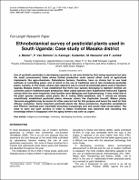| dc.contributor.author | Mwine, J | |
| dc.contributor.author | Damme, Van P. | |
| dc.contributor.author | Kamoga, G. | |
| dc.contributor.author | Kudamba | |
| dc.contributor.author | Nasuuna, M. | |
| dc.contributor.author | Jumba, F. | |
| dc.date.accessioned | 2018-07-25T09:23:23Z | |
| dc.date.available | 2018-07-25T09:23:23Z | |
| dc.date.issued | 2010 | |
| dc.identifier.citation | Mwine, T.J., Van Damme, P., Gerard, K. and Charles, K., 2011. Ethnobotanical survey of pesticidal plants used in South Uganda: Case study of Masaka district. Journal of Medicinal Plants Research, 5(7), pp.1155-1163. | en_US |
| dc.identifier.issn | 1996-0875 | |
| dc.identifier.uri | http://hdl.handle.net/20.500.12280/530 | |
| dc.description.abstract | Use of synthetic pesticides in developing countries is not only limited by their being expensive but also
the small (uneconomic) fields whose limited production costs cannot offset costs of agricultural
implements like agro-chemicals. Subsistence farmers, therefore, have no choice but to use local
methods of controlling pests, one of which is the use of traditional and of late introduced pesticidal
plants’ extracts. In this study, whose main objective was to record all pesticidal plants used in Southern
Uganda, Masaka district, it was established that thirty four species belonging to eighteen families are
currently used in traditional plant production. Most useful species were Azadirachta indica and Tagetes
minuta while the most frequently cited families were Meliaceae and Euphorbiaceae. It was noted that of
the plant species recorded, some plants like A. indica, Melia azedarach, and T. minuta are already
scientifically established pesticidal plants whereas others like Euphorbia tirucalli, Bidens pilosa,
Vernonia amygdalina may be known for other uses but not for this purpose and hence the need for their
efficacy evaluation. Some important pesticidal plants like Abrus precatorius, Euphorbia candelabrum
and Phoenix reclinata were reportedly becoming increasingly rare and would need conservation. The
need to carry out such surveys in order to obtain inventories was observed and recording this
knowledge before it disappears with the aging farmers was seen as urgent. | en_US |
| dc.language.iso | en | en_US |
| dc.publisher | Academic Journals | en_US |
| dc.subject | Indigenous knowledge | en_US |
| dc.subject | Inventory | en_US |
| dc.subject | Developing countries | en_US |
| dc.subject | Conservation | en_US |
| dc.title | Ethnobotanical survey of pesticidal plants used in South Uganda: Case study of Masaka district | en_US |
| dc.type | Article | en_US |


